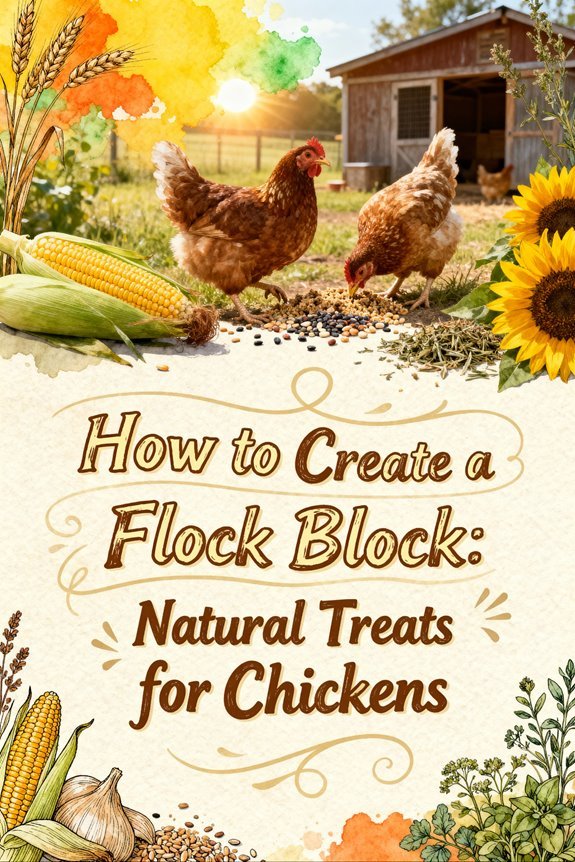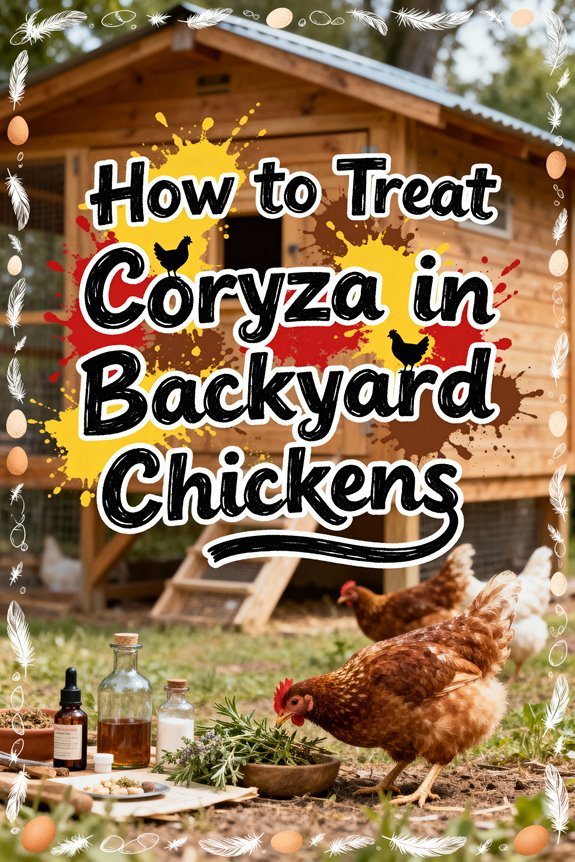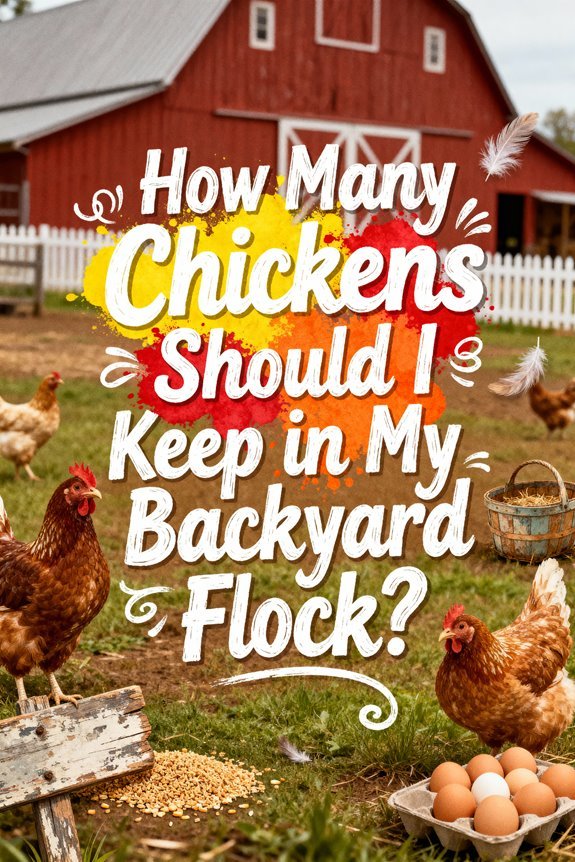How to Create a Flock Block: Natural Treats for Chickens
You can create nutritious flock blocks by combining protein sources like mealworms and sunflower seeds with binding agents such as molasses and coconut oil. Mix your dry ingredients thoroughly, add wet components until sticky, then compress firmly into baking pans. Bake at 325°F-350°F until set. Store blocks in airtight containers and offer as supplements to chickens over 8 weeks old. The science behind flock block nutrition reveals key strategies for maximizing your birds’ health benefits.
Benefits of Homemade Flock Blocks for Your Chickens
While commercial feed provides basic nutrition, homemade flock blocks offer extensive benefits that enhance your chickens’ health and well-being. You’ll boost your flock’s immune system with additional protein and essential vitamins, while the high-quality ingredients support ideal egg production and meat bird growth. Molasses or lard serves as a natural adhesive to bind ingredients effectively.
These blocks greatly impact flock happiness by encouraging natural foraging behaviors and reducing boredom-related issues like feather pecking. Maintaining optimal protein levels around 16-18% helps ensure proper growth and development. Adding dark leafy greens enhances the nutritional value and improves egg yolk quality. They’re cost-effective alternatives that help you minimize food waste while providing controlled nutrition. The customizable ingredients let you adjust for seasonal needs, with warming spices offering respiratory support during winter months.
You’ll notice improved chicken health through better digestion, enhanced circulation, and sustained energy levels. The blocks’ long-lasting nature guarantees fresh feed availability while deterring predators through strategic spice inclusion.
Essential Ingredients for a Nutritious Flock Block
Creating an effective flock block starts with selecting the right combination of high-quality ingredients that deliver balanced nutrition. Your base protein sources should include eggs and grubs or mealworms, complemented by black oil sunflower seeds and wheat germ. You’ll need reliable binding agents like blackstrap molasses and melted coconut oil to hold the block together, while flour or rolled oats provide structural support. This supplemental treat helps reduce boredom behaviors in confined chickens. While chickens are often used as disease sentinels for monitoring mosquito-borne illnesses, their primary nutritional needs remain the focus of flock block creation.
To enhance nutritional value, incorporate herbs such as oregano and thyme for immune support, along with crushed garlic and ground cinnamon for digestive health. Adding ripe papaya provides protein-digesting enzymes that support overall poultry health. Don’t forget essential carbohydrates from scratch grains and cracked corn, which provide sustained energy. You’ll want to adjust fat content seasonally, using more coconut oil or lard during colder months and reducing it in summer to optimize your flock’s energy needs.
Step-by-Step Mixing and Preparation Guide
Before diving into the mixing process, you’ll need to properly prepare your workspace and ingredients. Preheat your oven to 325°F-350°F and line your baking pans with parchment paper or apply a light coating of grease. Starting with high-quality grains similar to commercial feeds ensures proper nutrition for your flock.
Using proper mixing techniques, combine your dry ingredients thoroughly in a large bowl, guaranteeing even distribution of herbs and grains. In a separate bowl, whisk together your wet ingredients until fully blended. The ingredient ratios are essential – gradually incorporate the wet mixture into the dry components while stirring continuously. You’ll want to achieve a sticky, uniform consistency that’s not quite dough-like. Adding ingredients like coconut oil helps bind the mixture while providing beneficial nutrients.
Press the mixture firmly into your prepared pan, compacting it well to make sure the block holds together. This compression step is vital for achieving the right texture and structural integrity during baking. The finished flock block will provide your chickens with hours of entertainment while they peck and feed.
Proper Storage and Preservation Methods
Once your flock blocks have finished baking and cooling, proper storage methods will determine their longevity and nutritional preservation. Following best practices, you’ll need to store them in a cool, dry place away from direct sunlight and pests. For moisture control, wrap blocks tightly in plastic and foil before placing them in airtight containers.
You can refrigerate blocks for up to one week or freeze them for 2-3 months. When freezing, portion blocks into manageable sizes and label them with preparation dates. After thawing, don’t refreeze them, as this compromises their quality. For room temperature storage, hang blocks using twine or cut smaller portions to minimize exposure. Hanging feeders with flock blocks provides enrichment while helping maintain freshness. Monitor blocks regularly for signs of mold or deterioration, and rotate stock to maintain ideal freshness.
When and How to Feed Flock Blocks
While flock blocks serve as valuable nutritional supplements for chickens, proper timing and feeding methods are essential for their effectiveness. Don’t introduce these treats until your chickens reach at least 8 weeks of age, as younger chicks require finely milled starter feed for their delicate digestive systems.
Your feeding strategies should focus on offering flock blocks as supplements rather than primary nutrition. Place them on cookie sheets within the run area where chickens can access them freely during daylight hours. For a flock of 16 or more, space multiple blocks to prevent competition. Remove uneaten portions by evening to discourage pests. The freshly-ground whole grains provide essential nutrients while encouraging natural pecking behaviors. Maintaining a clean coop environment is crucial for ensuring your chickens will eat their treats in designated areas and maintain optimal egg production.
Consider adding ripe persimmons to your flock blocks for additional vitamins and antioxidants that support immune health. Monitor consumption carefully, as the 9% protein content isn’t sufficient to replace layer feed. They’re particularly beneficial during cold weather or when chickens have limited foraging opportunities.
Seasonal Variations and Adaptations
Successful flock blocks require thoughtful adaptations throughout the year to match your chickens’ changing nutritional needs. In winter, you’ll need to increase energy-dense ingredients like cracked corn and healthy fats, while summer blocks should focus on cooling herbs and reduced corn content.
Adjust your binding methods seasonally: winter blocks demand firmer consistency using more molasses and flour, while summer blocks can maintain a looser texture. You’ll want to modify seasonal ingredients based on your flock’s activity levels and stress factors. During winter confinement, provide larger blocks to combat boredom, but reduce block size when summer free-ranging offers natural forage. Adding cayenne pepper for digestion can be especially beneficial during cold weather. Make feeding adjustments by increasing protein during molting periods and boosting anti-inflammatory ingredients like cinnamon during colder months.
Monitoring Your Flock’s Response and Consumption
Four essential metrics require consistent monitoring when introducing flock blocks to your chickens: consumption patterns, behavioral responses, health indicators, and social dynamics.
Start by measuring pre-portioned amounts of flock blocks and track how much your birds consume over specific time periods. Through behavioral observations, you’ll need to watch for signs of acceptance, competition, or avoidance around the blocks. Monitor your flock’s health by checking body condition scores, egg production rates, and digestive health regularly. Adding natural Vitamin E to flock blocks can enhance immunity and improve meat quality in your birds. Adding fresh garlic to flock blocks helps boost immune function and naturally repels parasites. You’ll also want to document social interactions, noting whether the blocks trigger increased cooperation or competition among your birds. Adjust your flock block recipes to include nutrient-dense treats during spring when chickens need extra nutrition for increased production.
Keep a detailed log of your findings, including consumption rates, behavioral changes, and health indicators. This data will help you adjust block recipes and feeding schedules for maximum results.



